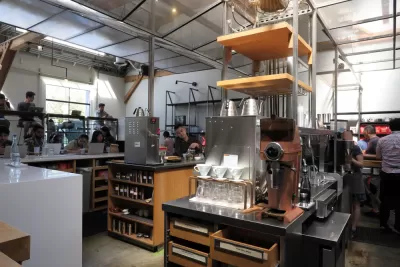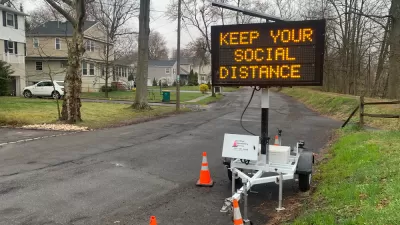The Los Angeles Times published a pair of incendiary articles this week in which coffee plays an integral role in the conversation about gentrification.

Ruben Vives reports on the ongoing gentrification controversies embroiling the Los Angeles neighborhood of Boyle Heights. The latest site of conflict in Boyle Heights is Weird Wave Coffee.
Anti-gentrification forces spent weeks trolling the coffee house on Instagram before and after it opened June 15. They held protest rallies outside the business, holding posters, including one that read “… White Coffee” and included an expletive, and another that said “AmeriKKKano to go.” They passed out fliers with a parody logo that read “White Wave.”
The protests of the coffee shop shift slightly the site of anti-gentrification political action away from art galleries. The Los Angeles Times has documented previous actions in August 2016, November 2016, and February 2017.
A day later, columnist Robin Abcarian began an examination of gentrification in the neighborhood of Venice with an anecdote about a short drive to a Blue Bottle coffee shop on the popular Abbot Kinney commercial corridor. The op-ed is a strongly worded response to Wall Street Journal analysis published earlier this month finding evidence that the neighborhood's building envelope has been shrinking as its popularity grows.
Alissa Walker, among others, responded to Abcarian's anti-development stance on social media.
FULL STORY: A community in flux: Will Boyle Heights be ruined by one coffee shop?

Planetizen Federal Action Tracker
A weekly monitor of how Trump’s orders and actions are impacting planners and planning in America.

Chicago’s Ghost Rails
Just beneath the surface of the modern city lie the remnants of its expansive early 20th-century streetcar system.

San Antonio and Austin are Fusing Into one Massive Megaregion
The region spanning the two central Texas cities is growing fast, posing challenges for local infrastructure and water supplies.

Since Zion's Shuttles Went Electric “The Smog is Gone”
Visitors to Zion National Park can enjoy the canyon via the nation’s first fully electric park shuttle system.

Trump Distributing DOT Safety Funds at 1/10 Rate of Biden
Funds for Safe Streets and other transportation safety and equity programs are being held up by administrative reviews and conflicts with the Trump administration’s priorities.

German Cities Subsidize Taxis for Women Amid Wave of Violence
Free or low-cost taxi rides can help women navigate cities more safely, but critics say the programs don't address the root causes of violence against women.
Urban Design for Planners 1: Software Tools
This six-course series explores essential urban design concepts using open source software and equips planners with the tools they need to participate fully in the urban design process.
Planning for Universal Design
Learn the tools for implementing Universal Design in planning regulations.
planning NEXT
Appalachian Highlands Housing Partners
Mpact (founded as Rail~Volution)
City of Camden Redevelopment Agency
City of Astoria
City of Portland
City of Laramie





























